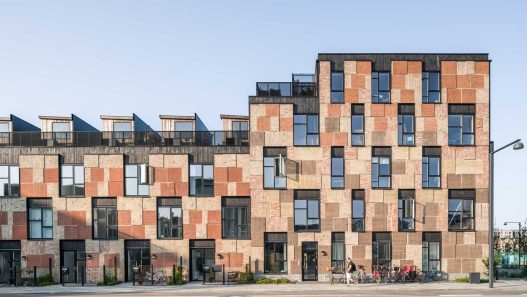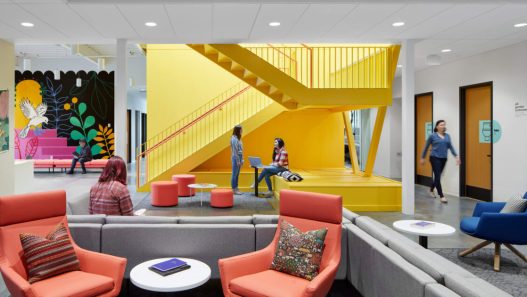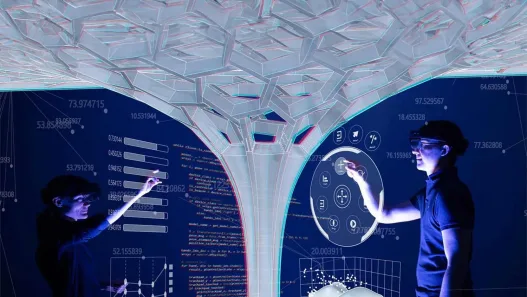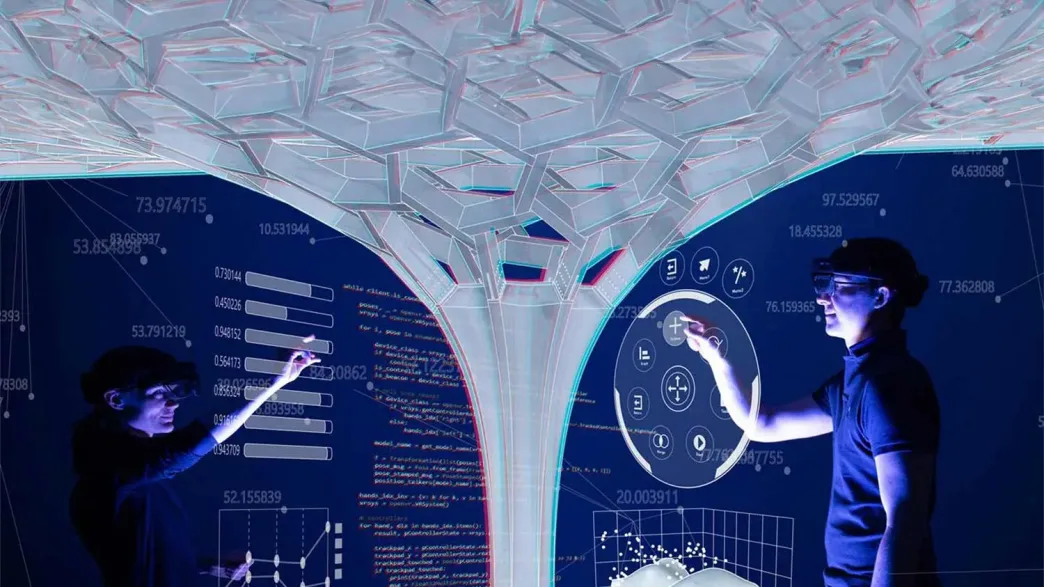Cybernetic architecture represents a fascinating blend of technology and design, where artificial intelligence (AI) meets structural innovation. This field explores how intelligent systems can enhance architectural processes, creating spaces that dynamically respond to their environment and the needs of their inhabitants.

Description and Overview
In essence, cybernetic architecture refers to the integration of cybernetics (the study of systems, control and communication in animals and machines) into architectural design. This approach emphasises feedback loops, adaptability and interaction, allowing structures to respond intelligently to both internal dynamics and external stimuli. Imagine buildings that adjust their heating and cooling systems according to occupancy or facades that change according to weather conditions. Cybernetic architecture promotes a more responsive and sustainable way of living by encouraging a symbiotic relationship between the built environment and its users.
Historical Context
The roots of cybernetic architecture date back to the mid-20th century, when rapid advances in technology began to influence various fields, including design and engineering. Pioneers such as Norbert Wiener, who laid the foundations of cybernetics, inspired architects to think beyond static structures. In the 1960s and 1970s, architects such as Cedric Price and the Archigram team experimented with ideas of flexibility and adaptability in architecture, designing spaces that could evolve over time. These discoveries laid the foundation for what would later become known as cybernetic architecture, combining the ideas of dynamic systems with architectural applications.
Importance in Modern Design
In today’s world, where environmental concerns and urban challenges are more urgent than ever, cybernetic architecture is of great importance. It promotes sustainability by making buildings more energy efficient and sensitive to their environment. For example, smart buildings equipped with sensors can optimise energy use, reduce waste and cut costs. Furthermore, this approach improves the user experience, making spaces more comfortable and functional. As cities grow and evolve, the need for adaptive and intelligent designs becomes critical, making cybernetic architecture a vital component of modern urban planning.
Key Names of Cybernetic Architecture
Many influential figures have contributed to the development of cybernetic architecture. One important architect is Nicholas Negroponte, co-founder of the MIT Media Lab, which explores the interaction between technology and design. His ideas on responsive environments have inspired many contemporary architects to incorporate digital technologies into their projects. Another important figure is Greg Lynn, known for his work on the integration of blob architecture and computational design. Lynn’s innovative use of algorithms embodies the principles of cybernetics, showing how architecture can be both fluid and structured. These architects and others have paved the way for a new understanding of how technology can enhance our built environment.
Future Directions
Looking ahead, the future of cybernetic architecture holds exciting developments. As artificial intelligence continues to develop, we can expect even more sophisticated applications in design and construction. Imagine buildings with self-learning capabilities that adapt to user preferences over time, or urban areas that communicate with each other to optimise traffic flow and resource management. The integration of virtual and augmented reality could also change the way architects visualise and interact with their designs, enabling immersive experiences that foster creativity and collaboration. As we embrace these developments, the potential for cybernetic architecture to redefine our relationship with the built environment becomes truly limitless, promising a future where our spaces are not just structures, but responsive ecosystems that enhance our quality of life.
The world of architecture is undergoing a profound transformation with the integration of artificial intelligence (AI) and innovative structural applications. Cybernetic architecture represents this exciting frontier where architects and engineers are harnessing the power of AI to push the boundaries of design, functionality and sustainability. In exploring this intersection, we reveal how AI is reshaping our built environment, fostering creativity, and even raising important ethical questions.
The Role of Artificial Intelligence
Artificial intelligence plays a pivotal role in modern architectural practice, significantly improving the design and construction processes. By automating complex tasks and providing insights through data analysis, AI is transforming the way architects conceptualise and realise their visions. This section examines various aspects of AI’s role, from its impact on design to its ethical implications.
Artificial Intelligence in Design Processes
Artificial intelligence is revolutionising design processes in architecture by enabling more dynamic and responsive design workflows. Traditionally, architects have relied heavily on manual processes to develop plans and visualise structures. With AI tools, designers can now use algorithms that analyse large amounts of data to inform their designs. These tools can recommend optimal layouts based on factors such as site conditions, environmental impact and even user preferences.
Imagine an architect designing a new public space. By utilising artificial intelligence, they can simulate how different design options may affect foot traffic, light exposure and even acoustic properties. This capability allows for a more intuitive design process where architects can iterate quickly and make informed decisions that improve user experience and functionality.
Machine Learning Applications
Machine learning, a subset of artificial intelligence, involves training algorithms to recognise patterns and make predictions based on data. In architecture, this technology finds application at various stages, from initial concept development to post-occupancy analysis. For example, machine learning can analyse historical data from similar projects to predict how a new building will perform in terms of energy efficiency or occupant satisfaction.
An interesting example is the use of machine learning to optimise building energy consumption. By analysing data from sensors in a building, algorithms can learn how different factors such as occupancy levels and weather conditions affect energy use. This information enables real-time adjustments, enabling buildings to operate at peak efficiency while minimising energy waste.
Artificial Intelligence Driven Structural Analysis
Structural analysis is a critical component of architecture that ensures buildings are safe, robust and sustainable. Artificial intelligence significantly improves this process by providing advanced tools that can analyse complex structural systems more efficiently than traditional methods. By simulating various stress and load scenarios, AI can identify potential weaknesses in a design before construction begins.
For example, during the design phase of a skyscraper, AI can be used to analyse site-specific wind patterns and seismic activity. By predicting how the structure will respond to these forces, architects can make informed decisions about materials and design elements, ultimately resulting in safer and more durable buildings.
Artificial Intelligence in Architecture Case Studies
Several groundbreaking projects demonstrate the profound impact of AI in architecture. One notable example is the AI-generated “Dancing House” design in Prague, where algorithms helped optimise the building’s unique, fluid form. The design process involved extensive data analysis and simulations, resulting in a structure that not only attracts attention but also fulfils functional needs.
Another example is the use of artificial intelligence in urban planning. Cities such as Singapore have adopted AI technologies to analyse urban density and traffic patterns, helping to develop smart city initiatives. These projects aim to create more livable, efficient and sustainable urban environments by utilising data-driven insights.
Ethical Considerations in the Application of Artificial Intelligence
As architects and engineers embrace AI, ethical considerations must also come to the fore. The integration of AI raises questions regarding job substitution, data privacy, and the potential for algorithmic bias. For example, if AI systems are trained on historical data that reflect biases, they may inadvertently perpetuate these biases in new designs or planning decisions.
Moreover, reliance on AI tools can lead to a disconnect between human creativity and machine-generated outputs. It is crucial that architects remain involved in the design process, ensuring that their unique perspectives and ethical considerations guide the application of AI technologies.
As a result, cybernetic architecture fuelled by AI is reshaping the future of design and construction. By understanding the role of AI in design processes, machine learning applications, structural analysis and the ethical implications of its use, we can harness its potential to create innovative, sustainable and human-centred architectural solutions. The challenge as we move forward is to ensure that our built environment best reflects human creativity and ingenuity, balancing technological progress with ethical responsibility.
Cybernetic architecture represents a fascinating blend of technology and creativity, where artificial intelligence (AI) meets innovative structural design. This approach is not only redefining how buildings are designed, but also revolutionising their functionality, adaptability and sustainability. In examining the structural innovation techniques shaping this field, we reveal how architects are utilising these advanced concepts to create spaces that are not only aesthetically pleasing, but also sensitive to both human needs and environmental challenges.
Structural Innovation Techniques
Structural innovation techniques are at the centre of cybernetic architecture, allowing architects to explore new forms and functions. Each technique pushes the boundaries of traditional architecture, bringing a unique perspective on how we can design and interact with our built environment.
Parametric Design
Parametric design is a game-changing approach that uses algorithms to create complex forms and structures. By defining parameters and rules, architects can produce a variety of design solutions that respond dynamically to inputs. This flexibility allows for a more organic and iterative design process where changes can be made effortlessly. For example, a building designed with parametric principles can adapt its shape depending on environmental factors such as sunlight, wind direction and even occupant preferences. The Heydar Aliyev Centre in Baku, designed by Zaha Hadid, exemplifies this approach by exhibiting fluid forms that are difficult to achieve through traditional methods.
Responsive Building Materials
The emergence of responsive building materials marks a significant shift in architectural design. These materials react to environmental stimuli such as temperature or humidity, allowing buildings to adapt in real time. Imagine a façade that changes its opacity depending on sunlight, reducing glare and heat gain during the day while allowing natural light when needed. The Eastgate Centre in Zimbabwe is a perfect example, where materials respond to the climate, mimicking the natural ventilation of termite mounds, resulting in energy-efficient buildings that remain comfortable year-round.
Biomimicry in Architecture
Biomimicry takes inspiration from nature to solve human design challenges. By studying natural systems, architects can develop innovative solutions that promote efficiency and sustainability. For example, the Eden Project in the UK uses geodesic domes inspired by natural organisms to create a microclimate for various plant species. This form not only provides structural stability, but also reduces the energy required for heating and cooling and shows how lessons from nature can lead to smarter, more sustainable designs.
Modular Building Approaches
Modular construction involves assembling pre-fabricated sections or modules off-site before transporting them to the construction site for final assembly. This technique streamlines the construction process, reduces waste and can significantly shorten construction times. A striking example is the Marriott Residence Inn, which utilised modular construction to complete a 120-room hotel in just a few days. This method allows greater control over quality and can be adapted for a variety of uses, from residential units to commercial buildings, making it a versatile choice in modern architecture.
Sustainability and Environmentally Friendly Solutions
Sustainability is an important consideration in contemporary architecture and cybernetic structures are leading the way in environmentally friendly solutions. Architects are increasingly integrating renewable energy sources such as solar panels and wind turbines into building designs. Furthermore, the use of green roofs and walls helps to improve air quality and reduce heat absorption in urban areas. The Bosco Verticale in Milan, with its vertical forests, not only increases biodiversity but also provides natural insulation, demonstrating how architecture can harmonise with the environment.
In conclusion, structural innovation techniques in cybernetic architecture offer a promising future for building design. By adopting parametric design, responsive materials, biomimicry, modular construction and sustainable practices, architects are not only creating buildings; they are creating environments that are intelligent, adaptable and in harmony with both human needs and the natural world. This intersection of technology and architecture invites us to envision a built environment that is not only functional but also a living part of the ecosystem.
Cybernetic architecture represents a fascinating blend of technology, biology and design; artificial intelligence and structural innovation come together to create buildings that are not only functional but also responsive to their environment. This approach to architecture emphasises adaptability, sustainability and a dynamic interaction between the building and its inhabitants, making it a vital concept in contemporary design.
Important Examples of Cybernetic Architecture
As cybernetic architecture evolves, several projects stand out as remarkable examples of how artificial intelligence and innovative structural techniques can redefine our built environment. These projects exemplify the principles of sensitivity and intelligence in architectural design.
Paradise Project
Located in the heart of Cornwall, England, the Eden Project is a living testament to the principles of cybernetic architecture. This extraordinary complex features massive geodesic domes that harbour diverse ecosystems from around the world. The design is not only aesthetic; it also incorporates advanced environmental control systems that monitor and adjust humidity, temperature and light levels to create optimal conditions for plant growth. The integration of these automated systems allows the Eden Project to function almost like a living organism, responding to its internal and external environment. Thanks to its innovative design, the Eden Project not only showcases biodiversity, but also creates a model for sustainable architecture by emphasising the importance of ecological balance.
High Line
The High Line in New York is another example of cybernetic architecture redesigning urban space. Originally an elevated railway, the High Line has been transformed into a vibrant urban park that integrates nature and public space within the bustling cityscape. The park’s design incorporates smart technologies that allow it to adapt to the needs of users by monitoring visitor flow, weather conditions and plant health. The High Line acts as a social connector, encouraging interaction and community engagement, while also supporting biodiversity in an urban environment. This project demonstrates how cybernetic principles can revitalise neglected spaces and transform them into sustainable and interactive environments.
Bosco Verticale
The Bosco Verticale, or “Vertical Forest” in Milan, exemplifies the fusion of nature and architecture with its innovative design. The residential complex consists of two towers planted with thousands of trees and plants, creating a vertical ecosystem that contributes to urban biodiversity. The architectural design not only enhances the aesthetic appeal of the buildings, but also improves air quality and reduces energy consumption. The integration of intelligent irrigation systems and AI-driven environmental controls allows plants to thrive while requiring minimal maintenance. Bosco Verticale shows how cybernetic architecture can harmonise urban life with nature and provides a blueprint for future developments in densely populated areas.
The Edge in Amsterdam
The Edge in Amsterdam is touted as one of the smartest buildings in the world. This office space exemplifies the potential of cybernetic architecture, utilising the latest technology to improve workplace efficiency and comfort. Equipped with an array of sensors and artificial intelligence systems, the building monitors and adjusts lighting, temperature and even air quality according to occupants’ preferences. The Edge is designed for maximum flexibility, allowing spaces to be easily reconfigured to accommodate different working styles. This smart design not only supports employee well-being, but also reduces energy consumption, creating a model for sustainable office environments.
Qatar National Museum
The Qatar National Museum showcases an innovative architectural approach that embodies the principles of cybernetic design. Its unique, organic form is inspired by the desert rose, a natural crystal formation found in the region. The museum utilises advanced technology to create dynamic exhibition spaces that can adapt to a variety of exhibitions and events. The building’s design utilises passive cooling techniques and intelligent energy management systems to provide a sustainable approach to climate control in a harsh desert environment. Blending traditional cultural elements with modern technology, the Qatar National Museum acts as a bridge between the past and the future, demonstrating how cybernetic architecture can honour heritage while embracing innovation.
Ultimately, these notable examples of cybernetic architecture demonstrate the transformative potential of integrating artificial intelligence and innovative design. Each of these projects not only addresses current challenges in sustainability and urban living, but also enhances the users’ experience through dynamic and responsive environments. As technology continues to evolve, the possibilities for cybernetic architecture are limitless and promise a future where our built environments can adapt and evolve with us.
Challenges in Cybernetic Architecture
When we enter the field of cybernetic architecture, we uncover not only the potential for revolutionary designs and intelligent structures, but also a set of challenges that need to be addressed. These challenges are multifaceted and include technical limitations, economic viability, public acceptance, regulatory issues, and the delicate balance between innovation and tradition. Understanding these barriers is crucial for architects, engineers and urban planners as they navigate this exciting yet complex landscape.
Technical Limitations
At the core of cybernetic architecture is the integration of artificial intelligence (AI) with traditional architectural practices. While AI offers extraordinary capabilities such as real-time data analysis, predictive modelling and adaptive systems, there are inherent technical limitations that can hinder progress. One of the biggest challenges is the need for reliable and robust technology that can handle the vast amounts of data generated in smart buildings. This includes everything from environmental sensors to occupancy monitoring systems. If these technologies fail or provide inaccurate data, the entire system can become inefficient or even unsafe.
Moreover, the integration of AI into architectural designs requires sophisticated software and hardware that may not always be readily available or affordable. This dependence on advanced technology can create a gap between innovative concepts and their practical application. Furthermore, interoperability between various systems and devices is often lacking, making it difficult for architects to create seamless, integrated environments that truly harness the potential of cybernetic principles.
Economic Viability
Economic factors play an important role in determining the success of a cybernetic architecture. While the initial investment in AI-driven systems can be significant, the long-term benefits often remain uncertain. Stakeholders should weigh the costs of implementing these advanced technologies against potential savings in energy efficiency and operating costs. For many developers, upfront costs may deter investment in cybernetic projects, especially in regions where traditional building methods are considered more cost-effective.
Furthermore, the economic landscape is continually evolving, influenced by market trends, technological advancements, and shifts in consumer preferences. As society becomes more aware of sustainability and smart living, the demand for innovative architectural solutions may increase, but the path to widespread adoption remains fraught with financial risks. Architects and developers must find a way to demonstrate the economic benefits of cybernetic architecture to persuade investors and clients of its value.
Public Acceptance and Perception
Public perception of cybernetic architecture can significantly influence the adoption of this technology. While many people are attracted to the idea of smart buildings that are responsive to their occupants, there is also an inherent scepticism about the technology. Concerns about privacy, data security and the potential for surveillance can create resistance among potential users. Moreover, the idea of machines making decisions about the human environment can evoke fears of loss of control or autonomy.
To encourage acceptance, architects and designers should prioritise transparency about how data is collected and used, and ensure that users feel informed and safe. Public engagement through education and outreach can also play a vital role in shaping perceptions. Stakeholders can help allay fears and build trust within communities by demonstrating the tangible benefits of cybernetic architecture, such as improved energy efficiency, enhanced comfort and increased safety.
Regulatory and Compliance Issues
Navigating the regulatory environment for cybernetic architecture poses another significant challenge. As this field brings together elements of technology, construction and design, it is often covered by multiple regulatory frameworks that can be complex and inconsistent. Building codes, safety regulations and zoning laws may not yet take into account the unique aspects of smart systems, leaving architects in a grey area where compliance is uncertain.
In addition, the rapid pace of technological advancement can outpace existing regulations and create a situation where innovative designs may inadvertently violate outdated codes. This can lead to delays in project approvals or even outright rejections, preventing the implementation of cutting-edge concepts. To address these issues, collaboration between architects, policymakers, and technologists is essential to develop comprehensive guidelines that support innovation while ensuring public safety and welfare.
Balancing Innovation and Tradition
Finally, the challenge of balancing innovation and architectural tradition cannot be ignored. While cybernetic architecture represents a bold leap forward, it is rooted in the rich history of architectural design. Many societies value the aesthetic and cultural significance of traditional architecture, which may conflict with the futuristic nature of cybernetic designs. Striking the right balance requires a thoughtful approach that respects the historic context while embracing new technologies.
Architects should engage with local stakeholders to understand their values and preferences and integrate traditional elements into modern designs where possible. This may involve using materials and forms that resonate with the community while incorporating intelligent systems that enhance functionality. Ultimately, the aim is to create spaces that feel familiar and warm, while at the same time pushing the boundaries of what architecture can achieve in the 21st century.
In conclusion, while cybernetic architecture holds great promise for the future of design and construction, it is crucial to address the challenges that accompany this innovation. By balancing technical limitations, economic viability, public perception, legal barriers and tradition with modernity, architects can pave the way for a new era of smart, responsive buildings that enhance our built environment.
Future Perspectives
As we conclude our examination of cybernetic architecture, it is important to reflect on the profound changes this field has experienced and its potential to reshape our built environment. Cybernetic architecture combines technology with design, enabling buildings to respond dynamically to their environment. This innovative approach not only improves functionality, but also encourages a deeper connection between residents and their environment.
Summary of Key Insights
Throughout our journey, we have seen how cybernetic architecture is redefining traditional building practices. By integrating artificial intelligence, architects can create spaces that adapt to human needs and environmental conditions. For example, smart buildings equipped with sensors can improve energy efficiency and comfort by adjusting lighting and temperature based on occupancy. This combination of technology and design emphasises the importance of responsive environments, paving the way for a more sustainable future.
The Evolving Role of Architects
The role of architects in this new paradigm is changing dramatically. No longer just creators of static designs, architects must become integrators of technology. They are tasked with understanding complex algorithms and data analyses to inform their designs. Collaboration with engineers, data scientists and environmental experts is becoming increasingly vital. This multi-disciplinary approach not only broadens the architect’s skill set, but also enriches the design process, leading to innovative solutions that prioritise human experience and ecological impact.
Forecasts for the Next Decade
Looking ahead, we can expect significant advances in cybernetic architecture over the next decade. As artificial intelligence continues to develop, we will likely see even more sophisticated systems that enhance building performance and user interaction. Imagine buildings that can learn from their occupants, adjusting their layout or features to improve functionality. Furthermore, with increasing urbanisation, we can expect to see these concepts applied in smart city developments, where interconnected structures communicate to optimise resources and reduce waste. The integration of renewable technologies will also play a crucial role and make buildings not only energy efficient but also energy generating.
Future Research
As we stand on the threshold of this architectural revolution, it is vital that students, professionals and enthusiasts actively engage with these concepts. Educational institutions should encourage the next generation of architects to think critically about the role of technology in design by incorporating cybernetics and artificial intelligence into their curricula. Workshops, hackathons and collaborative projects can stimulate innovative ideas and solutions. By fostering a culture of experimentation and discovery, we can collectively push the boundaries of what cybernetic architecture can achieve.
Final Thoughts on Cybernetic Architecture
In summary, cybernetic architecture represents an exciting fusion of technology and design and offers a glimpse into a future where our buildings are alive, responsive and in harmony with nature. As we embrace this potential, we must be mindful of ethical considerations to ensure that the technology serves humanity and the planet. The journey ahead is full of possibilities and our exploration of cybernetic architecture is just beginning. Together, we can shape a future where our built environments reflect, nurture and inspire the dynamic interplay between nature and technology.





















